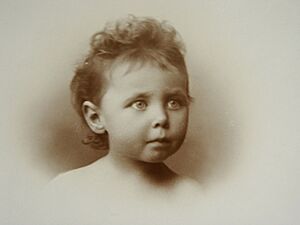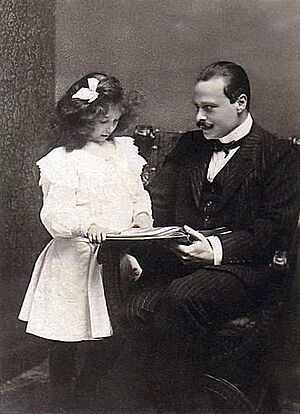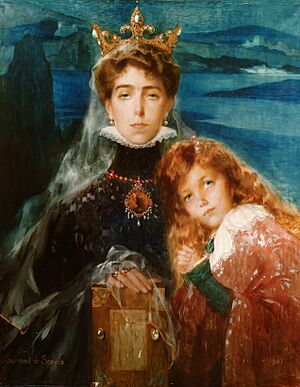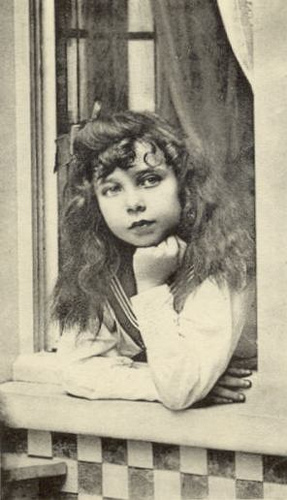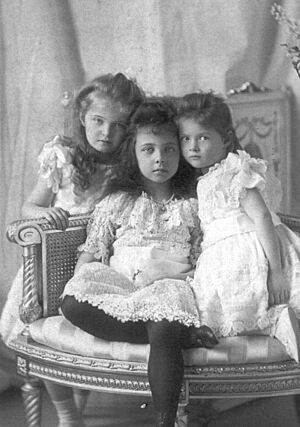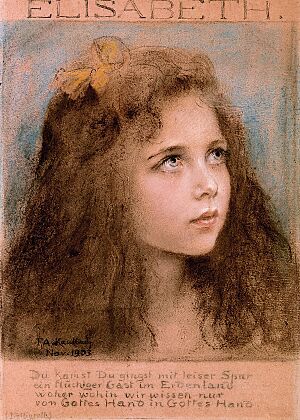Princess Elisabeth of Hesse and by Rhine (1895–1903) facts for kids
|
||||||||||||||||||||||
Princess Elisabeth of Hesse and by Rhine (born March 11, 1895 – died November 16, 1903) was a young German princess. She was the only daughter of Ernst Ludwig, Grand Duke of Hesse and by Rhine, and his first wife, Princess Victoria Melita of Saxe-Coburg and Gotha.
Elisabeth was named after her great-grandmother, Princess Elisabeth of Prussia. Her aunt also had the same name. Both the young princess and her aunt were often called Ella. Elisabeth's early death was a sad event. Some people thought she might have been poisoned by mistake, but doctors said she died from a serious illness called typhoid fever. This was likely caused by drinking water from a dirty stream.
Her Early Life
Elisabeth's parents, known as ‘Ernie’ and ‘Ducky’, were cousins. They married because their grandmother, Queen Victoria, wanted them to. But their marriage was not a happy one. Princess Victoria Melita was 18 when Elisabeth was born. She loved Elisabeth, but her father, Ernst, was especially devoted to their daughter.
Ernst believed he understood Elisabeth even before she could speak. When she was six months old, he asked her about her favorite colors for her new nursery. He said she made happy sounds when he showed her a certain shade of lilac. So, he decorated her room in lilac colors.
He also had a special playhouse built for her in its own garden. Only children were allowed inside this playhouse. Adults, including her nannies and teachers, had to wait outside.
Her Childhood
Margaretta Eagar, a governess for Elisabeth's cousins, said Elisabeth was "a sweet and pretty child." She had wide grey-blue eyes and lots of dark hair. She was much like her mother in looks and manners.
When she was four, Elisabeth wanted a baby sister. She even tried to convince her aunt and uncle, Tsarina Alexandra and Tsar Nicholas II, to let her parents adopt one of her cousins. Her parents later had another child, a son, but he was stillborn in 1900.
Elisabeth was a favorite of her great-grandmother, Queen Victoria. The Queen called her "my precious." Queen Victoria did not want Elisabeth's parents to divorce because of the child. In 1899, when Queen Victoria turned 80, she wanted to see Elisabeth first and receive her birthday wishes.
When Elisabeth heard Queen Victoria’s pony cart, she ran to the balcony. She waved and called, "Granny Gran, I’m here!" Her playful spirit made the Queen laugh. Elisabeth was also there when Queen Victoria passed away in 1901. She sat next to her cousin Prince Edward of York during the Queen's funeral.
Her father wrote in his memories that Elisabeth had a "deep sensitivity" and a "very large heart." He said she had a strong personality that kept her from being spoiled.
In October 1901, after Queen Victoria died, Elisabeth’s parents divorced. This meant Elisabeth spent her year living in two different places: Darmstadt with her father and Coburg with her mother. At first, Elisabeth was not happy about the divorce. She missed her father and found it hard to trust her mother.
Her father said it was difficult to get Elisabeth to visit her mother. Before one visit, he found her "whimpering under a sofa, full of despair." He told her that her mother loved her. Elisabeth replied, "Mama says she loves me, but you do love me." Despite her sad eyes, Elisabeth was usually a happy child. She often helped her cousins make up when they argued.
Her Final Days
In October 1903, Elisabeth's father hosted a big family gathering in Darmstadt. This was for the wedding of his niece, Princess Alice of Battenberg. A few weeks later, he took Elisabeth to visit his sister, Tsarina Alexandra, and her family. They stayed at the imperial family’s hunting lodge in Skierniewice, Poland. Elisabeth enjoyed long walks and picnics in the forest with her cousins.
One morning, the eight-year-old Elisabeth woke up with a sore throat and chest pains. Her fever rose very high. The imperial family did not think her illness was serious at first. They went to the theater as planned. But by evening, Elisabeth was in more pain and struggling to breathe. A special doctor was called from Warsaw. He gave her medicine to help her heart, but it did not work.
Her governess, Eagar, wrote that Elisabeth suddenly sat up in bed. She looked around with wide, scared eyes and cried out, "I’m dying! I’m dying!" She was encouraged to lie down but remained restless. She asked for a telegram to be sent to her mother right away. Doctors told Tsarina Alexandra that Elisabeth's mother should be told. But the telegram did not arrive until the next morning, after Elisabeth had already passed away. An examination after her death confirmed she died of a severe typhoid infection.
Funeral and Memory

Elisabeth’s body was placed in a silver coffin, a gift from Tsar Nicholas II. It was taken back to Darmstadt. Her father planned a special "white funeral." Everything was white instead of black: the decorations, the flowers, and even the horses for the procession. Thousands of people came to watch the funeral. Her father wrote that he could hear them sobbing.
Her cousin, Kaiser Wilhelm II, was shocked by her death. He wrote to Tsar Nicholas II, saying how joyful and full of life Elisabeth had been. Elisabeth was buried in the Rosenhöhe, a special burial place for her family. A marble angel was later placed to watch over her grave. Her mother, Victoria Melita, placed her special Order of Hesse badge into Elisabeth’s coffin as a final goodbye.
Her father, Ernst, was still heartbroken by her death even thirty years later. In his memories, he wrote, "My little Elisabeth was the sunshine of my life."
Images for kids



